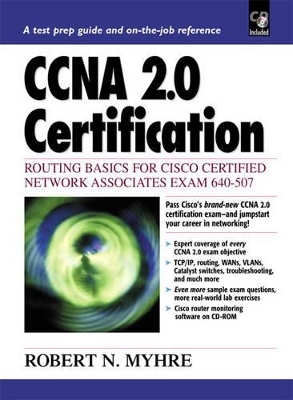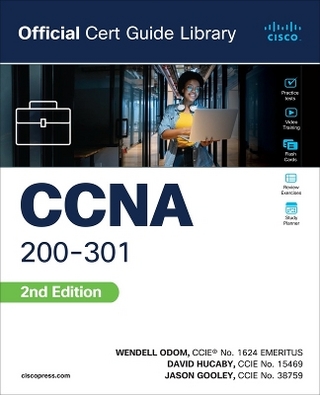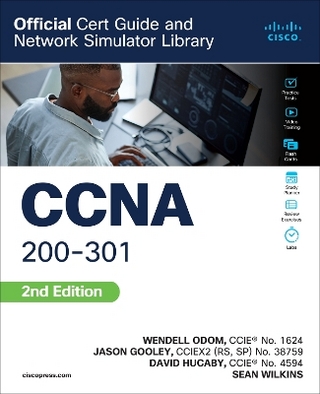
CCNA 2.0 Certification
Prentice Hall
978-0-13-090308-2 (ISBN)
- Titel ist leider vergriffen;
keine Neuauflage - Artikel merken
Uses task-oriented approach to teach Cisco routing basics.
The current CCNA 1.0 exam is being retired on July 31, 2000: CCNA candidates are demanding books that cover the new CCNA 2.0 exam. In CCNA 2.0 Certification, one of the world's leading Cisco trainers covers everything exam candidates need to know to pass the new exam -- and succeed as Cisco networking professionals. This update of the best-selling First Edition includes extensive new coverage of Virtual LANs, the Cisco Catalyst Switch, and other topics demanded by the new CCNA 2.0 exam. Coverage also includes: the fundamentals of networking and the OSI model; Cisco routers, switches, repeaters, and bridges; TCP/IP addressing and subnetting; the fundamentals of routing and dynamic routing; Cisco router boot methods; IPX/SPX configuration; TCP/IP and IPX/SPX access lists; WAN technologies; debugging, and more. This new Second Edition also contains more lab exercises, more multiple-choice questions, and a new CD-ROM containing powerful software for monitoring Cisco networks.
ROBERT N. MYHRE, CCNP, CCDP, MCSE+I, MCT, MCSD, is an independent consultant and an instructor specializing in Cisco and Microsoft networking, including LAN/WAN implementation, network administration, and software development. He is an instructor with Ascolta Training Company, LLC, specializing in teaching Cisco internetworking.
1. Introduction to Networking and the OSI Model.
Introduction to Networking. The OSI Model. Why Use a Layered Model? How Does a Model Work? Application Layer (Layer 7). Presentation Layer (Layer 6). Session Layer (Layer 5). Transport Layer (Layer 4). Network Layer (Layer 3). Data Link Layer (Layer 2). Physical Layer (Layer 1). Data Encapsulation Using the OSI Model. Summary. Scenario Lab 1.1. Exam Objective Checklist. Practice Questions.
2. LAN Technologies.
Ethernet. CSMA/CD. Physical Layer. Data Link Layer. Types of Ethernet. Token Ring. Physical Layer. Data Link Layer. Fault Tolerance. FDDI. Physical and Data Link Layers. ATM. Physical and Data Link Layers. LAN Emulation (LANE). Summary. Scenario Lab 2.1. Exam Objective Checklist. Practice Questions.
3. Repeaters, Bridges, Routers, and Switches.
LAN Segmentation. Repeaters. Bridges. Routers. Switches. Virtual LANs, or VLANs. Summary. Scenario Lab 3.1. Exam Objective Checklist. Practice Questions.
4. TCP/IP.
The OSI Model versus the TCP/IP Model. Internet Protocol (IP). Address Resolution Protocol (ARP). Internet Control Message Protocol (ICMP). Transmission Control Protocol (TCP). User Datagram Protocol (UDP). Application Layer Protocols. File Transfer Protocol (FTP). Trivial File Transfer Protocol (TFTP). Telnet. Simple Network Management Protocol (SNMP). Other Protocols and Applications. Summary. Scenario Lab 4.1. Exam Objective Checklist. Practice Questions.
5. Introduction to Cisco Routers.
Cisco Products Overview. Switches. Catalyst 1900 Series. Catalyst 2820 Series. Catalyst 2900 Series. Catalyst 5000 Series. Routers. Cisco 700 Series. Cisco 1600 Series. Cisco 2600 Series. Cisco 3600 Series. Cisco 4000 Series. Cisco 7000 Series. Learning More. Cisco 2500 Series Access Routers. Router Architecture. IOS. Configuring the Cisco Router. Configuration Script Install. Manual Configuration Using CLI. Connecting Routers to Each Other. Summary. Scenario Lab 5.1. Practice Lab 5.1. Practice Lab 5.2. Exam Objective Checklist. Practice Questions.
6. TCP/IP Addressing.
Binary Counting. Addressing Principles. Classes of Addresses. Class A. Class B. Class C. Class D and Class E. Class Summary. Subnet Masks. Assigning TCP/IP Addresses. Setting up Cisco Routers. Summary. Scenario Lab 6.1. Practice Lab 6.1. Practice Lab 6.2. Exam Objective Checklist. Practice Questions.
7. TCP/IP Subnetting.
What Is Subnetting? Why Subnet? Finding the Subnet Mask. Step#1. Step#2. Step#3. Step#4. Finding the Number of Hosts/Subnets. Finding the Number of Subnets. Finding the Number of Hosts per Subnet. Populating the Subnets. Calculating the Subnet Addresses. Calculating the Host IDs. Supernetting. Configuring IC, Inc. Step#1. Step#2. Step#3. Router 1. Router 2. Router 3. Summary. Scenario Lab 7.1. Practice Exercise 7.1. Practice Exercise 7.2. Practice Exercise 7.3. Practice Lab 7.1. Practice Lab 7.2. Exam Objective Checklist. Practice Questions.
8. Static TCP/IP Routing.
Static Routing Concepts. Configuring Routers for Static Routes. Router 1. Router 2. Router 3. Troubleshooting. Default Routing. Summary. Scenario Lab 8.1. Practice Lab 8.1. Practice Lab 8.2. Practice Lab 8.3. Exam Objective Checklist. Practice Questions.
9. Catalyst Switch Operations.
Introduction to Catalyst 1900. Configuring the Switch. Bridging. VLANs. How ISL Works. Configuring the ISL Switch. Summary. Practice Lab 9.1. Practice Lab 9.2. Exam Objective Checklist. Practice Questions.
10. Dynamic Routing.
Routed Versus Routing Protocols. Interior Versus Exterior Routing Protocols. Differences Among Interior Gateway Protocols. Distance Vector. Link State. Classful Versus Classless. Routing Information Protocol. Additional RIP Knowledge. Interior Gateway Routing Protocol. Multiprotocol Routing (MPR). Summary. Scenario Lab 10.1. Practice Lab 10.1. Practice Lab 10.2. Practice Lab 10.3. Exam Objective Checklist. Practice Questions.
11. Managing the Cisco Router.
Disasters Can Occur. The Boot Process. Working with the IOS Image. Working with the Configuration Files. Lost Passwords. Summary. Scenario Lab 11.1. Practice Lab 11.1. Practice Lab 11.2. Exam Objective Checklist. Practice Questions.
12. IPX/SPX.
IPX/SPX Model. Network Addressing. Encapsulation. Configuring Cisco Routers. Service Advertisement Protocol. Get Nearest Server. Summary. Scenario Lab 12.1. Practice Lab 12.1. Exam Objective Checklist. Practice Questions.
13. Security with Access Lists.
Basics of Access Lists. IPX Access Lists. Standard Access Lists. Extended Access Lists. SAP Filters. IP Access Lists. Standard Access Lists. Extended Access Lists. Summary. Scenario Lab 13.1. Practice Lab 13.1. Practice Lab 13.2. Practice Lab 13.3. Exam Objective Checklist. Practice Questions.
14. WAN Technologies.
How Serial Links Work. HDLC. PPP. ISDN. BRI. PRI. Frame Relay. Configuring Frame Relay on Cisco Routers. Subinterfaces. Summary. Scenario Lab 14.1. Exam Objective Checklist. Practice Questions.
15. Extra Features of the Cisco Router.
Cisco Discovery Protocol. Show Commands. Debugging. Telnet. Logging. Usernames. Summary.
Appendix A: Answers to Practice Questions.
Appendix B: Answers to Practice Exercises.
Appendix C: Hierarchical Command Structure.
Appendix D: AppleTalk.
Index.
| Erscheint lt. Verlag | 7.12.2000 |
|---|---|
| Verlagsort | Upper Saddle River |
| Sprache | englisch |
| Maße | 183 x 242 mm |
| Gewicht | 1215 g |
| Themenwelt | Mathematik / Informatik ► Informatik ► Netzwerke |
| Informatik ► Weitere Themen ► Zertifizierung | |
| ISBN-10 | 0-13-090308-6 / 0130903086 |
| ISBN-13 | 978-0-13-090308-2 / 9780130903082 |
| Zustand | Neuware |
| Haben Sie eine Frage zum Produkt? |
aus dem Bereich


